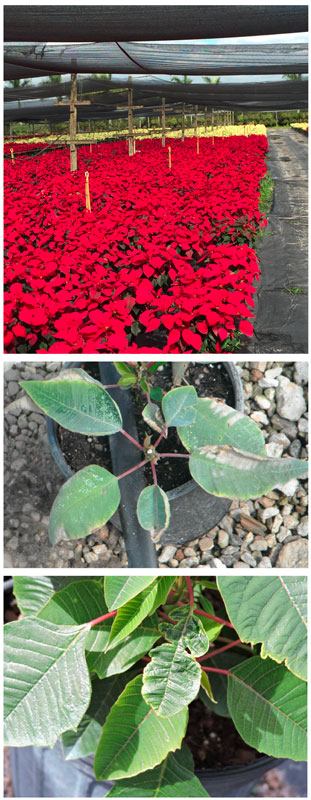5/1/2023
Poinsettia Fertilization Tricks
Lynn Griffith
 Pictured: Poinsettia production in Florida.
Pictured: Poinsettia production in Florida.
• When you pinch a rooted cutting back to five or six breaks, you get a lot of new shoots, which often depletes the old leaves of magnesium.
• Molybdenum-deficient poinsettia.
As you read this, poinsettia growers are starting to receive rooted cuttings in order to build up their stock for this year’s November/December sales. Stock plants of almost any kind need more magnesium inputs than production plants. There are a couple of reasons for this: 1) Among the primary functions of magnesium in plants is that it’s in the middle of the chlorophyll molecule; and 2) it’s a mobile element. When a plant runs low in magnesium, it transfers magnesium from the older leaves to the newer leaves.
Well, what do stock producers do? They come in and take a bunch of cuttings, which removes a lot of magnesium from the stock plant. It’s very important for poinsettia growers not only to apply extra magnesium to their stock, but to treat with magnesium before the rooted cuttings are pinched.
When you pinch a rooted cutting back to five or six breaks, you get a lot of new shoots, which often depletes the old leaves of magnesium. This causes marginal yellowing in the older leaves or older leaf loss. Magnesium deficiency is best handled preventatively with soil applications. Older leaves don’t absorb foliar magnesium as well.
You can certainly spray magnesium as either sulfate, nitrate or chelate. However, a soil drench application with magnesium prior to pinching will help maintain attractive leaf color and health in older foliage. Common application rates are 2 lb. of magnesium sulfate, 2 qt. of magnesium nitrate or 2 qt. of magnesium chelate per hundred gallons. Check your labels. These magnesium sources are generally compatible with fungicides and insecticides. You don’t necessarily need an extra drench.
Poinsettias require more molybdenum than most crops. I know growers who have produced millions of poinsettias who feel that the crop can’t get enough molybdenum. I advise my growers to spray their poinsettias with 1 oz. of sodium or ammonium molybdate per 100 gal. about every two weeks. This way, every new tier of leaves gets a molybdenum spray as they develop. The tender developing foliage absorbs molybdenum well.
Which source of molybdenum you use doesn’t really matter—it’s only an ounce per hundred gallons or roughly a 1 to 13,000 dilution. The tiny amount of sodium or ammonium you’re adding is inconsequential. Also, don’t worry about molybdenum toxicity in poinsettia. A study in the 1980s tried to induce and describe molybdenum toxicity in poinsettia. They were basically unsuccessful in creating molybdenum toxicity.
Most soluble 20-20-20 and 20-10-20 fertilizers on the market contain no calcium and very little magnesium. They also tend to lack sulfur. Cal Mag fertilizers such as 15-5-15 or 17-3-17 are popular with today’s poinsettia growers. Later in the crop, once the calcium and magnesium availability from dolomite in the media have dissipated, these fertilizers help maintain proper levels in media and tissue. Definitely run tissue analyses several times during poinsettia production. Collect tissue from the most recent fully matured leaves. Adjust your fertilizer inputs according to what the tissue analyses tell you.
Calcium is important for bract formation and avoiding bract necrosis in several poinsettia varieties. What many don’t know is that calcium isn’t actively absorbed by most plants; it simply comes in with the transpiration stream as plants absorb moisture. If days are cool, dark or damp, transpiration is reduced, and so is calcium absorption. Even with adequate calcium in the media, you may not be getting enough into the plant under these conditions. Foliar calcium sprays in the weeks before color development can be very important.
Another important factor in poinsettia production is nitrogen source. Absorption of nitrate is regulated in part by the carbohydrate concentration in the plant. It takes a lot of energy for plants to absorb nitrate nitrogen. You tend to get more compact growth with nitrate nitrogen, as opposed to ammonia or urea, especially in winter. In my experience, this is more and more important the further north your greenhouse is. In the South, days tend to be brighter and longer, so nitrogen source is somewhat less important.
Many growers like to shift their nitrogen sources to largely nitrate later in the season. I encourage this. By the way, molybdenum is the enzyme co-factor for nitrate reductase, which helps convert ammoniacal nitrogen to nitrate.
Boron is important in translocation and utilization of carbohydrates. This is a fancy way of saying that boron helps plants make sugars and move them around. Make sure you have adequate boron in your tissue analyses prior to bract formation. Some parts of the country have high boron in their irrigation water. Growers there may not need any supplemental boron at all. Realize that the range between deficiency and toxicity for boron is narrower than for other micronutrients.
Regarding height control, in poinsettia I like to keep one foot on the gas and one on the brake. By that, I mean keep your fertility in optimum ranges. Use PGRs as needed if you feel your plants may be getting too tall. Reducing fertility for height control in poinsettia may result in color and bract formation problems.
Finally, I try to avoid applying foliar nutrients on poinsettia once bracts begin to form. You can do it to an extent, but applying foliar nutrients late is risky. I think this may have to do in part with not only the structure of the bract, but the relative temperature of the bract to the spray solution. Try to have your nutrient levels where you want them in the weeks before bract formation. GT
Lynn Griffith is a tropical plant and soil expert residing in Boca Raton, Florida.